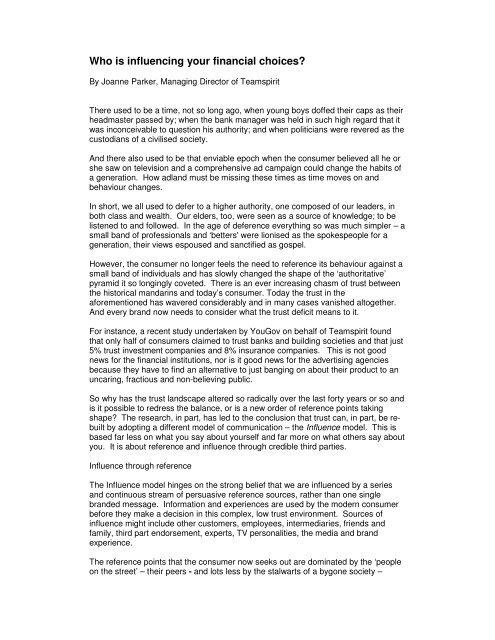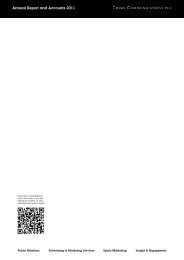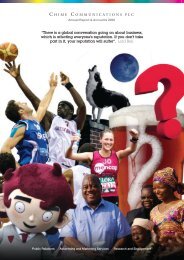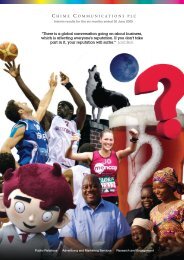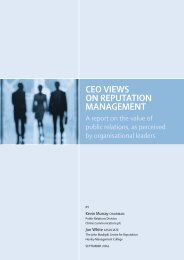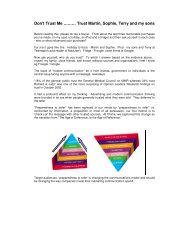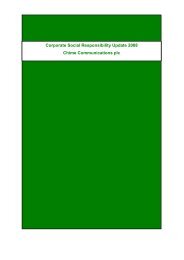Who is influencing your financial choices? - Chime Communications ...
Who is influencing your financial choices? - Chime Communications ...
Who is influencing your financial choices? - Chime Communications ...
- No tags were found...
Create successful ePaper yourself
Turn your PDF publications into a flip-book with our unique Google optimized e-Paper software.
<strong>Who</strong> <strong>is</strong> <strong>influencing</strong> <strong>your</strong> <strong>financial</strong> <strong>choices</strong>?By Joanne Parker, Managing Director of TeamspiritThere used to be a time, not so long ago, when young boys doffed their caps as theirheadmaster passed by; when the bank manager was held in such high regard that itwas inconceivable to question h<strong>is</strong> authority; and when politicians were revered as thecustodians of a civil<strong>is</strong>ed society.And there also used to be that enviable epoch when the consumer believed all he orshe saw on telev<strong>is</strong>ion and a comprehensive ad campaign could change the habits ofa generation. How adland must be m<strong>is</strong>sing these times as time moves on andbehaviour changes.In short, we all used to defer to a higher authority, one composed of our leaders, inboth class and wealth. Our elders, too, were seen as a source of knowledge; to bel<strong>is</strong>tened to and followed. In the age of deference everything so was much simpler – asmall band of professionals and ‘betters' were lion<strong>is</strong>ed as the spokespeople for ageneration, their views espoused and sanctified as gospel.However, the consumer no longer feels the need to reference its behaviour against asmall band of individuals and has slowly changed the shape of the ‘authoritative’pyramid it so longingly coveted. There <strong>is</strong> an ever increasing chasm of trust betweenthe h<strong>is</strong>torical mandarins and today’s consumer. Today the trust in theaforementioned has wavered considerably and in many cases van<strong>is</strong>hed altogether.And every brand now needs to consider what the trust deficit means to it.For instance, a recent study undertaken by YouGov on behalf of Teamspirit foundthat only half of consumers claimed to trust banks and building societies and that just5% trust investment companies and 8% insurance companies. Th<strong>is</strong> <strong>is</strong> not goodnews for the <strong>financial</strong> institutions, nor <strong>is</strong> it good news for the advert<strong>is</strong>ing agenciesbecause they have to find an alternative to just banging on about their product to anuncaring, fractious and non-believing public.So why has the trust landscape altered so radically over the last forty years or so and<strong>is</strong> it possible to redress the balance, or <strong>is</strong> a new order of reference points takingshape? The research, in part, has led to the conclusion that trust can, in part, be rebuiltby adopting a different model of communication – the Influence model. Th<strong>is</strong> <strong>is</strong>based far less on what you say about <strong>your</strong>self and far more on what others say aboutyou. It <strong>is</strong> about reference and influence through credible third parties.Influence through referenceThe Influence model hinges on the strong belief that we are influenced by a seriesand continuous stream of persuasive reference sources, rather than one singlebranded message. Information and experiences are used by the modern consumerbefore they make a dec<strong>is</strong>ion in th<strong>is</strong> complex, low trust environment. Sources ofinfluence might include other customers, employees, intermediaries, friends andfamily, third part endorsement, experts, TV personalities, the media and brandexperience.The reference points that the consumer now seeks out are dominated by the ‘peopleon the street’ – their peers - and lots less by the stalwarts of a bygone society –
doctors, min<strong>is</strong>ters, bank managers and the gentry. For instance, the opinions of Fernand Philip are more likely to carry weight and influence as to the efficacy of a newdrug than a leading physician or polititian. It <strong>is</strong> not that trust has d<strong>is</strong>solved but justthe sectors and individuals of society that we place most trust in have.For instance, the Teamspirit/YouGove survey concluded that whilst over 60% ofmarketing budgets of <strong>financial</strong> services are spent on advert<strong>is</strong>ing and direct mail, theyaccount for under 20% of influence. However, at the other extreme <strong>is</strong> PR andSponsorship which accounts for only about 15% of spend but a staggering 50% ofinfluence.And th<strong>is</strong> <strong>is</strong> one of the fundamental problems facing the <strong>financial</strong> institutions, forpeople no longer defer in making brand <strong>choices</strong> but refer to those closest to home.The opinions of those around them hold immense sway and unless brands canidentify the d<strong>is</strong>parate groups that make alliances, based on kinship, they will face anever increasing d<strong>is</strong>crepancy between their roots to market and the consumers root tochoice.PICTURE OF PYRAMIDThe social search engine of the consumer <strong>is</strong> their quickest route to the most crediblesource. Students open bank accounts based on the collective experience of ahandful of their friends and their family; their mortgage <strong>is</strong> likely to be placed from asearch of the internet offerings; and the dec<strong>is</strong>ion as to choice of IFA, for any moneyleft over after paying their student debts, <strong>is</strong> probably going to be referred to them by afriend or because they read about them in an influential paper or magazine.Research has also shown that <strong>financial</strong> journal<strong>is</strong>ts, who are special<strong>is</strong>ts in their field,are considered particularly influential in guiding choice.Thus the marketing and advert<strong>is</strong>ing agencies are going to have to change the waythat they model their communications campaigns from one still rooted in thedeference camp to one that <strong>is</strong> based on referential thinking.In the age of deference the credibility of the message actually grew with the degreeof d<strong>is</strong>tance from the recipients. However, with the changing model, towards areference one, credibility <strong>is</strong> gained through more intimate channels and mechan<strong>is</strong>ms.Brands that ins<strong>is</strong>t on being authoritative and d<strong>is</strong>tant will fail to see the consumerconnecting with their message.Minimizing the R<strong>is</strong>kYet with the dem<strong>is</strong>e of deference the consumer has had to think for themselves moreand make dec<strong>is</strong>ions based on information gleaned from supposed knowledgeablesources. With th<strong>is</strong> responsibility has come a more complex dec<strong>is</strong>ion making processwhich incorporates a subliminal r<strong>is</strong>k analys<strong>is</strong>.Th<strong>is</strong> r<strong>is</strong>k analys<strong>is</strong> can be applied to consumers purchasing dec<strong>is</strong>ions, asking whatr<strong>is</strong>ks customers are hoping to minimize when they buy and thus what sort ofinformation they require in order to feel confident that they have made the rightdec<strong>is</strong>ion.The RISKS MATRIX – graph
When consumers make <strong>choices</strong> they are hoping to minimize two fundamental typesof r<strong>is</strong>k – the Social R<strong>is</strong>k and the Economic R<strong>is</strong>k.The Social R<strong>is</strong>k <strong>is</strong> the r<strong>is</strong>k of looking stupid, out of touch, un-cool, or otherw<strong>is</strong>em<strong>is</strong>guided by buying the wrong car, the wrong pension scheme, joining the wrongbank or having the wrong type of credit card.The Economic R<strong>is</strong>k <strong>is</strong> the r<strong>is</strong>k of losing more than face by making a poorlyperforming investment, losing money on a property purchase or investing in thewrong ISA that fails to deliver what it suggested.Financial service products (certainly longer-term ones such as pensions andinvestments) tend to fall into the Information categories, which have a high <strong>financial</strong>r<strong>is</strong>k but a much lower social r<strong>is</strong>k. Th<strong>is</strong> was confirmed in the recent research studyundertaken by Teamspirit and YouGov which asked customers who or what hadinfluenced their choice when they last purchased a <strong>financial</strong> services product.Regarding the purchasing of pensions, the majority cited their employer or an IFA asthose most likely to influence their dec<strong>is</strong>ion.SOURCES OF INFLUENCE –PERSONAL INVETMENT PRODUCTThe biggest chunk of influence by some margin <strong>is</strong> now newspaper articles – thepersonal finance pages in particular – and publ<strong>is</strong>hed league tables givingindependent comparative information. Influence by friends and family, and also IFAs,featured strongly, but paid-for media content had a much lower claimed effect. Thelatter <strong>is</strong> of some concern given the traditional patterns of media spend in th<strong>is</strong> sector.However, as always there are variations in the level of influence media plays aproposthe type of <strong>financial</strong> service being offered. For instance, the Teamspirit/YouGovresearch found that the choice of credit card was still reflective of the traditionalspending pattern i.e. that advert<strong>is</strong>ing continued to play an important role, as did salespromotion. Th<strong>is</strong> was in contrast to mortgages where nearly 40% of those included inthe survey claimed that they were influenced either by family and friends or by IFAs(Independent Financial Adv<strong>is</strong>ers), and another 29% responded to impartial mediaadvice, such as <strong>financial</strong> articles in papers.But will the banks and insurers take heed and begin to redress the importance theyattribute to straight forward media ads. The argument that brand advert<strong>is</strong>ing creates‘share of mind’ can not be d<strong>is</strong>m<strong>is</strong>sed out of hand, nor can the assumption thatconsumers can rarely give a full prove answer as to what or who influenced theirbuying dec<strong>is</strong>ion. However, the changing landscape <strong>is</strong> worth further investigating bythe <strong>financial</strong> services industry.For instance, for high net worth individuals the media <strong>is</strong> the key influence forInvestment Funds. Articles in the quality <strong>financial</strong> press play an immenselyd<strong>is</strong>proportionate influence in their dec<strong>is</strong>ion making. The research found that mediaand impartial information influenced 45% of those surveyed and IFAs influenced anadditional 23%. Advert<strong>is</strong>ing virtually fell of the map of influence, a point that shouldnot be m<strong>is</strong>sed by the large investment houses. A similar pattern immerged for equityrelease, where the influence of professional adv<strong>is</strong>ers <strong>is</strong> huge, around 54% and onceagain advert<strong>is</strong>ing playing a significantly reduced role.The <strong>financial</strong> services industry needs to spend smarter whilst achieving more. Nocompany has a bottomless pit of money and with the proliferation of media and the
continuing downward pressure on profits there <strong>is</strong> an obvious need for the markets tore-evaluate their marketing spend.At a time when trust between customers and the whole <strong>financial</strong> services industry <strong>is</strong>somewhat shaky the influence model could become the bedrock form which to buildan effective communications strategy. However the influence model <strong>is</strong> based not onthe old prem<strong>is</strong>e of AIDA (Awareness, Interest, Desire, Action) but on the simpler butmore comprehensive mechan<strong>is</strong>m of AIC (Awareness plus Influence equalsConversion)Dec<strong>is</strong>ion making <strong>is</strong> complex and far too complex to use the old, out-moded AIDAapproach. Th<strong>is</strong> linear model of trying to funnel as many consumers in one end whichdictated the eventual size of the market at the other end has been replaced by amore multifarious model – the new ‘Dec<strong>is</strong>ion Vortex’. Th<strong>is</strong> takes a diverse range ofreference points which are all d<strong>is</strong>tilled by the consumer prior to them making adec<strong>is</strong>ion. Whilst more complex, the eventual outcome <strong>is</strong> a better more solidrelationship between the consumer and the brands – one based on creatingawareness, through the influence of friends, family, colleagues and influential thirdparties.VORTEX - GRAPHNo one <strong>is</strong> advocating a total withdrawal of media based advert<strong>is</strong>ing, but what <strong>is</strong> onthe agenda <strong>is</strong> a more thought provoking mix of roots to market that challenges theold-guard theories personified by AIDA and large brand building communicationsstrategies so readily adopted by many leading <strong>financial</strong> service companies.The new agenda limits the weight attributed to certain traditional roots to market andchallenges the balance and interdependence between public relations, advert<strong>is</strong>ing,direct marketing and customer relationship management.Th<strong>is</strong> notion <strong>is</strong> best summed up by research reported by Michael Payne and LeonMacPherson that identified the importance of friends and IFAs in guiding choice forbanking and insurance products. They suggest strongly that there <strong>is</strong> a m<strong>is</strong>alignmentbetween the consumers’ reasons for choosing insurance and banking products andthe marketing techniques deployed – particularly the trend towards direct marketing.They call for a more effective bringing together of direct and indirect marketingactivities to mend th<strong>is</strong> apparent d<strong>is</strong>location.All-round integration of communications has long been a goal for the marketing andcorporate world alike. However, many find the idea difficult to work with in practice.Bringing the influence model thinking into the equation should give more meaningand a better indication of where and when each d<strong>is</strong>cipline will be most effective. Th<strong>is</strong>core process enables the development of better-focused campaigns and yieldsintegrated – not merely aggregated – marketing plans.Maxim<strong>is</strong>ing the power of influence for <strong>financial</strong> services brands through a moreeffective media mix <strong>is</strong> probably the biggest marketing opportunity around. But thechallenge <strong>is</strong> for both agency and client to introduce fresh ideas and d<strong>is</strong>card outdatedmodels that continue to cloud the communications picture.Ends
For further information, please contact Joanne Parker, Managing Director atTeamspirit on 020 7438 9400 or email her jparker@teamspirit.uk.com


